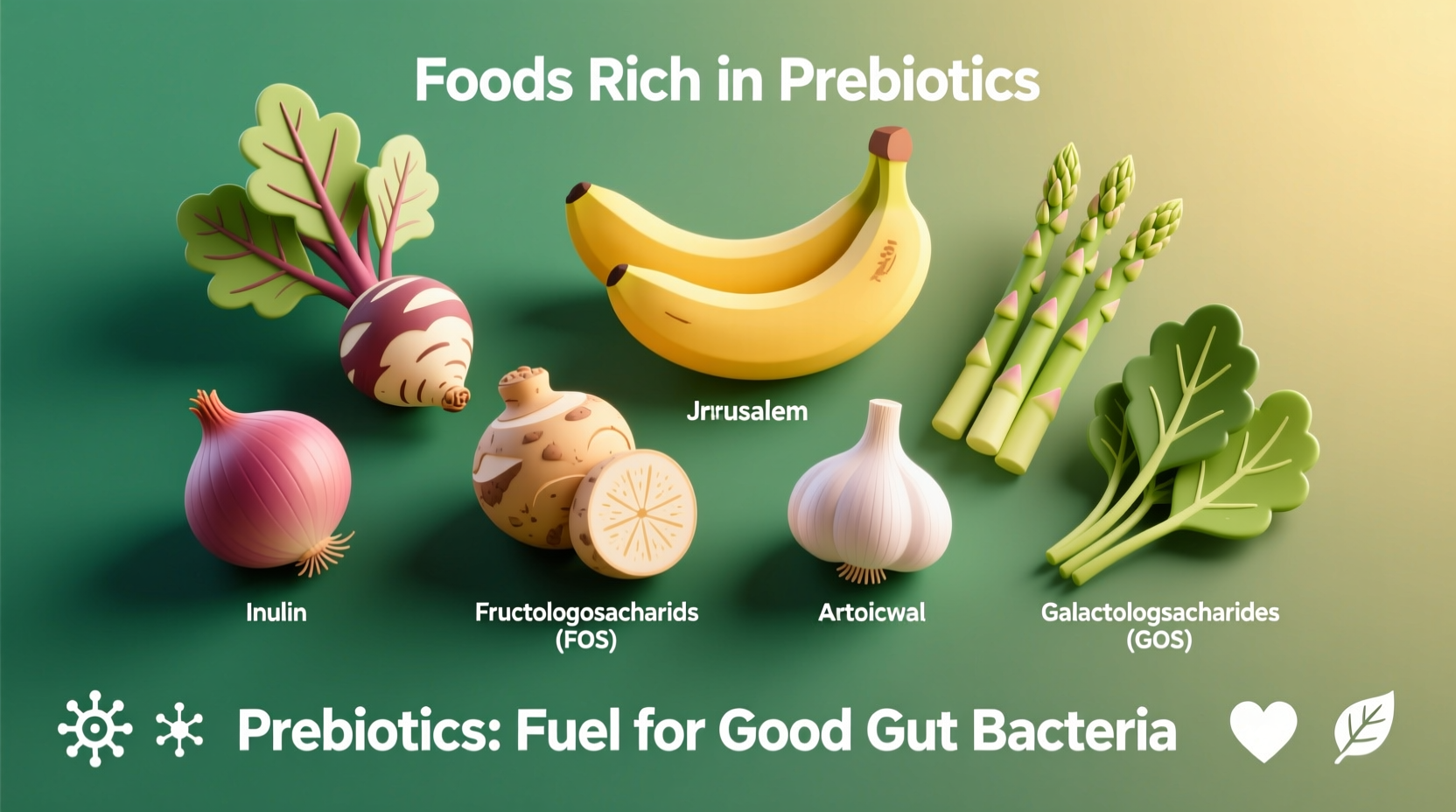When searching for what food has prebiotics, you're looking for natural sources that feed the beneficial bacteria in your gut. Unlike probiotics (live bacteria), prebiotics are non-digestible fibers that serve as food for these good microbes. The most potent prebiotic foods include garlic, onions, leeks, asparagus, bananas, oats, apples, flaxseeds, and Jerusalem artichokes. Incorporating just 3-5 grams of prebiotic fiber daily from these whole food sources can measurably improve gut microbiome diversity within weeks.
Top Prebiotic Foods You Should Eat Regularly
Based on clinical research and nutrient analysis, these foods contain the highest concentrations of prebiotic fibers like inulin, fructooligosaccharides (FOS), and galactooligosaccharides (GOS). The International Scientific Association for Probiotics and Prebiotics (ISAPP) confirms these as scientifically validated prebiotic sources.
| Food Source | Prebiotic Content (per 100g) | Key Prebiotic Compounds | Daily Serving Recommendation |
|---|---|---|---|
| Garlic | 17g | Inulin, FOS | 1-2 cloves (3-6g) |
| Jerusalem Artichoke | 16g | Inulin | 1 medium tuber (85g) |
| Chicory Root | 47g | Inulin | 1 tsp powder (2g) |
| Onions | 8.5g | Inulin, FOS | 1 medium onion (110g) |
| Leeks | 6.5g | Inulin | 1/2 cup chopped (40g) |
| Asparagus | 2.5g | Inulin | 5 spears (90g) |
| Green Bananas | 1.2g resistant starch | Resistant Starch | 1 medium banana (100g) |
| Oats | 2.3g beta-glucan | Beta-glucan | 1/2 cup dry (40g) |
How Prebiotic Foods Work in Your Gut
When you consume prebiotic fibers, they travel undigested to your colon where they're fermented by beneficial bacteria like Bifidobacteria and Lactobacilli. This fermentation process produces short-chain fatty acids (SCFAs) such as butyrate, which nourish your colon cells and reduce inflammation. According to research published in the American Journal of Clinical Nutrition, regular consumption of prebiotic foods can increase beneficial gut bacteria by 10-15% within 3 weeks.

Practical Ways to Add Prebiotics to Your Daily Meals
Instead of searching for what food has prebiotics as a theoretical question, implement these practical strategies:
- Breakfast boost: Add 1 tbsp ground flaxseeds or oats to your morning smoothie or yogurt
- Lunch enhancement: Include sliced onions, asparagus, or artichoke hearts in salads
- Dinner additions: Sauté garlic and leeks as a base for soups, stews, and sauces
- Smart snacking: Enjoy green bananas or apples with almond butter for a prebiotic-probiotic combo
Cooking note: Raw onions and garlic contain the highest prebiotic content, but light cooking (below 300°F/150°C) preserves most benefits. Avoid boiling prebiotic foods when possible, as this can leach fibers into water.
Prebiotic Research Timeline: How Our Understanding Has Evolved
The science of prebiotics has developed significantly over the past three decades:
- 1995: First formal definition of prebiotics established by Gibson and Roberfroid
- 2007: Human Microbiome Project launched, revealing gut bacteria's role in overall health
- 2016: International Scientific Association for Probiotics and Prebiotics (ISAPP) refined definition to require demonstrated health benefits
- 2020: Research confirms prebiotics support immune function beyond gut health
- 2023: Studies show personalized prebiotic responses based on individual microbiome composition
This evolution explains why some older sources might list foods as prebiotic that don't meet current scientific standards. Today's definition requires both selective stimulation of beneficial bacteria AND a demonstrated health benefit to the host.
Who Should Be Cautious With Prebiotic Foods
While prebiotics benefit most people, certain individuals should approach them carefully:
- IBS sufferers: Those with irritable bowel syndrome may experience bloating with high-FODMAP prebiotics like onions and garlic. Start with low-FODMAP options like oats and carrots.
- Small intestinal bacterial overgrowth (SIBO): May need to limit prebiotics during treatment phases
- Recent digestive surgery patients: Should consult with their healthcare provider before increasing fiber
The National Institute of Diabetes and Digestive and Kidney Diseases recommends gradually increasing prebiotic intake over 2-3 weeks to minimize digestive discomfort. Start with 2-3 grams daily and work up to 5-8 grams.
Prebiotic Foods vs. Supplements: What Research Shows
When considering natural prebiotic foods vs supplements, whole foods offer significant advantages:
- Nutrient synergy: Whole foods provide additional vitamins, minerals, and phytonutrients
- Lower risk of side effects: Supplements can cause more pronounced bloating at equivalent doses
- Longer-lasting benefits: Food matrix appears to support more diverse microbiome changes
According to a 2022 review in Nutrients, participants consuming prebiotic-rich whole foods showed 23% greater microbiome diversity improvement compared to those taking isolated prebiotic supplements at equivalent fiber doses.
Common Questions About Prebiotic Foods
Here are answers to frequent questions about incorporating prebiotic foods into your diet:
- How quickly do prebiotic foods work? Most people notice digestive improvements within 2-4 weeks of regular consumption.
- Can you get enough prebiotics from food alone? Yes, with proper food selection - you don't need supplements for general health.
- Do cooking methods affect prebiotic content? Light cooking preserves most benefits, but boiling can reduce prebiotic fibers.











 浙公网安备
33010002000092号
浙公网安备
33010002000092号 浙B2-20120091-4
浙B2-20120091-4